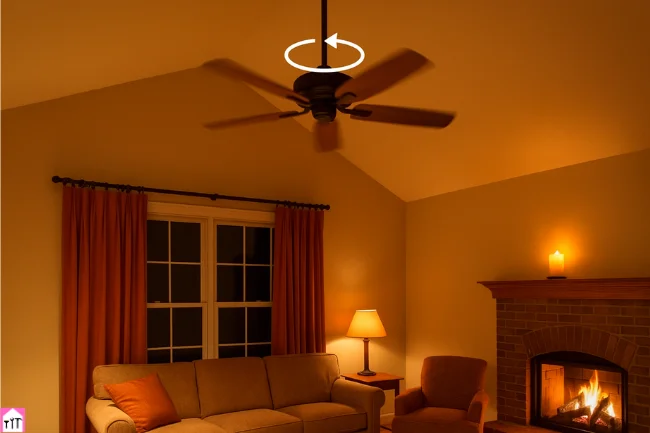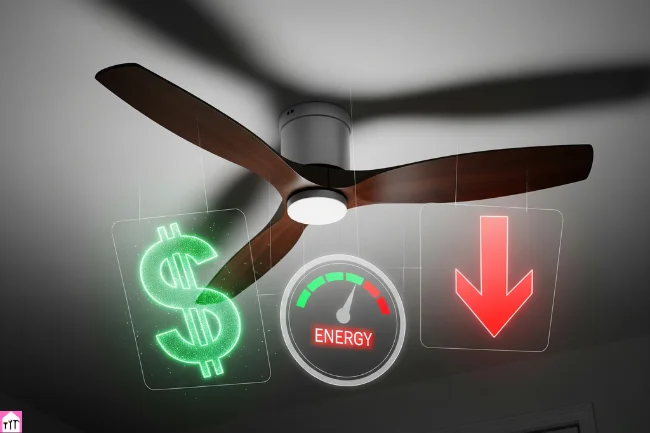
Understanding the proper direction for your ceiling fan can dramatically impact your home’s comfort and energy costs throughout the year. Whether you have a sleek modern fixture or a classic bronze ceiling fan with light, knowing when and how to adjust the blade rotation will help you maintain optimal indoor temperatures while reducing your reliance on heating and cooling systems.
Most homeowners install ceiling fans with the primary goal of staying cool during hot summer months, but these versatile fixtures serve a dual purpose when used correctly. The secret lies in understanding how air circulation patterns change based on blade rotation direction and how these patterns affect temperature distribution in your living spaces.
The Science Behind Ceiling Fan Airflow
Ceiling fans work by moving air throughout a room, creating wind chill effects that make you feel cooler even when the actual temperature remains unchanged. The direction of blade rotation determines whether air flows downward toward occupants or upward toward the ceiling, fundamentally altering how the fan affects room comfort.
When fan blades rotate counterclockwise, they push air downward, creating a direct cooling breeze on people below. This downward airflow increases evaporation from skin surfaces, producing the wind chill effect that can make temperatures feel up to eight degrees cooler. Conversely, clockwise rotation pulls air upward, drawing cool air from floor level toward the ceiling while gently circulating warmer air that naturally rises and collects near the ceiling back down along the walls.
Summer Settings for Maximum Cooling
During warm weather months, typically from late spring through early fall, your ceiling fan should rotate counterclockwise when viewed from below. This setting maximizes the cooling sensation by creating a direct downdraft that increases air movement across your skin.
The ideal speed setting varies depending on outdoor temperatures and personal preferences, but medium to high speeds generally provide the most effective cooling during peak summer heat. When properly configured, a ceiling fan running counterclockwise can allow you to raise your thermostat setting by three to four degrees without sacrificing comfort, resulting in significant energy savings on air conditioning costs.
For rooms with high ceilings, the counterclockwise summer setting becomes even more crucial. Heat naturally rises, and without proper air circulation, the temperature difference between floor and ceiling levels can become quite pronounced. The downward airflow helps distribute cooler air throughout the vertical space, preventing hot air from becoming trapped near the ceiling.
Winter Settings for Enhanced Warmth Distribution

When cold weather arrives, switching your ceiling fan to clockwise rotation transforms it from a cooling device into a heating efficiency booster. The upward airflow created by clockwise rotation gently redistributes warm air that collects near the ceiling, pushing it down along the walls and back into the occupied living space.
This winter setting should operate at low speeds to avoid creating uncomfortable drafts while still maintaining air movement. The goal is subtle circulation rather than the noticeable breeze desired during summer months. Many homeowners are surprised to discover that running ceiling fans during winter can reduce heating costs by making existing warm air more effective at maintaining comfortable temperatures throughout the room.
The winter clockwise setting proves particularly valuable in rooms with vaulted ceilings, where warm air tends to become stratified in upper areas far from where people spend their time. By gently mixing this warm air back into the lower portions of the room, ceiling fans help heating systems work more efficiently and reduce the temperature differential between floor and ceiling levels.
Finding the Ceiling Fan Direction Switch
Most ceiling fans include a small switch located on the motor housing that controls blade rotation direction. This switch may be positioned on the side of the motor housing or integrated into the fan’s control system. Some newer models include direction control in their remote controls or wall-mounted control panels, while others require manual adjustment of the physical switch on the unit itself.
Before adjusting the direction switch, always turn off the fan and allow the blades to come to a complete stop. Safety should be your primary concern when making any adjustments to ceiling fan settings. If you cannot easily reach the switch, use a sturdy step ladder rather than attempting to adjust it while standing on furniture or other unstable surfaces.
Seasonal Transition Timing
The optimal times to change ceiling fan direction align with your region’s seasonal temperature patterns. Generally, switch to counterclockwise rotation when you begin relying more on air conditioning than heating, typically in late April or early May in most temperate climates. The transition back to clockwise rotation should occur when heating systems start running regularly, usually in October or November.
These timing recommendations may vary based on your geographic location and local climate patterns. Homes in southern regions might benefit from counterclockwise operation for longer periods, while northern climates may require earlier switches to winter settings. Pay attention to your actual heating and cooling usage patterns rather than strictly following calendar dates.
Energy Efficiency Benefits

Proper ceiling fan direction settings contribute significantly to overall home energy efficiency. During summer months, the cooling effect of counterclockwise rotation allows homeowners to raise thermostat settings while maintaining comfort, reducing air conditioning load and associated energy consumption. Similarly, winter clockwise operation helps distribute heated air more effectively, potentially reducing the runtime of heating systems.
The energy consumed by ceiling fans themselves is minimal compared to heating and cooling systems. A typical ceiling fan uses approximately the same amount of electricity as a 75-watt light bulb, making them extremely cost-effective tools for improving indoor comfort and reducing HVAC system demands.
Maximizing Year-Round Ceiling Fan Comfort
Understanding and implementing proper ceiling fan direction changes represents a simple yet effective strategy for maintaining comfortable indoor temperatures throughout the year. Whether cooling yourself under the gentle downdraft of summer’s counterclockwise setting or benefiting from the subtle air mixing of winter’s clockwise rotation, your ceiling fan serves as a valuable partner in creating an energy-efficient, comfortable home environment.
Regular attention to these seasonal adjustments, combined with appropriate speed settings for current weather conditions, ensures your ceiling fans operate at peak efficiency regardless of the season. This small investment of time and attention pays dividends in both comfort and energy savings throughout the year.
